Classification, Functions, Sources, Absorption, Factors affecting absorption, Excretion, Deficiency - Macro Mineral Elements | 11th Biochemistry : Chapter 9 : Minerals
Chapter: 11th Biochemistry : Chapter 9 : Minerals
Macro Mineral Elements
Macro elements:
Some of
the macro elements are calcium, phosphorus, sodium, potassium, chloride,
magnesium and sulphur.
1. Calcium
· Calcium (Ca) is the most abundant inorganic mineral
in the body. About 99% of it exists in the bone and teeth and 1% in soft
tissues and extracellular fluid. Functions:
· Calcium plays a role in blood coagulation by
producing substances for thromboplastic activity of blood.
· Calcium is essential for bone and teeth formation.
· Calcium ions are necessary for nerve transmission
and muscle contraction.
· Normal excitability of heart is calcium dependent.
· Calcium is involved in the process of mitosis.
· It also acts as cofactor for certain enzymes like
succinate dehydrogenase.
· Calcium plays a role as secondary messenger in
hormone action.
· Calcium is involved in the process of membrane
fusion in endocytosis and exocytosis.
· It involves in maintenance of plasma membrane
potential.
· Calcium binds trypsin near its active site to
prevent autodigestion of trypsin.
Sources:
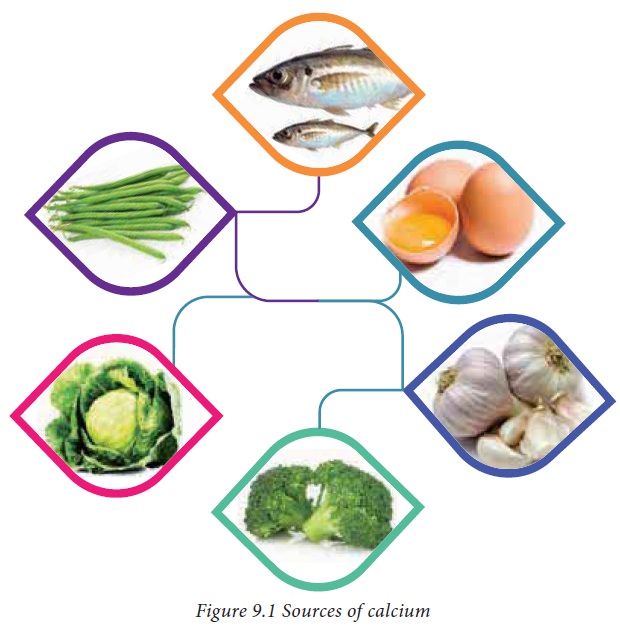
Dairy
products remain one of the most important dietary sources of calcium. Other
sources include egg-yolk, beans and cabbage.
Absorption:
Calcium
is taken in the diet as calcium salts of phosphate, carbonate, tartrate and
oxalate. Calcium is actively absorbed in the upper small intestine.
Factors affecting calcium absorption:
Many
factors are said to influence the absorption of the calcium in the intestine.
They
are:
1. pH: An acidic pH favours calcium absorption.
2. Protein: A high protein diet favours the absorption of
calcium.
3. Vitamin D: Vitamin D promotes absorption of calcium.
4. Sex hormones: Sex hormones seem to have an effect on calcium and phosphorus balance.
5. Lactic acid: Lactic acid produced by microbial fermentation of sugars in the gut,increases the solubility of
calcium salts, and increases their absorption.
6. Fatty acids: When the absorption of fats is impaired, calcium salts of fatty
acids are formed to a greater extent
retarding the absorption of calcium.
7. Oxalates: Oxalic acid from vegetables like cabbage, and spinach forms
insoluble calcium oxalates, thus
lowering the calcium absorption.
8. Phosphates: Excess of phosphate in diet lowers the calcium absorption. The
ratio of calcium and phosphorus in
the diet should be 1:1 for optimal absorption of calcium.
9. Phytic acid: Phytic acid present in cereals decreases absorption of calcium.
Excretion:
The
excretion of calcium is partly through the kidneys but mostly via small
intestine.
Small
amount of calcium may also be lost in sweat.
Deficiency:
Calcium
deficiency in body causes the following disorders.
Osteoporosis
Osteoporosis
is characterized by demineralization of bones (bone resorption) resulting in
progressive loss of bone density.
Tetany
Tetany
is a condition characterized by neuromuscular irritability and convulsion,
which is associated with a state of hypocalcaemia.
Rickets
Rickets
is more directly related to vitamin D deficiency, but calcium and phosphorus
metabolism are also involved.
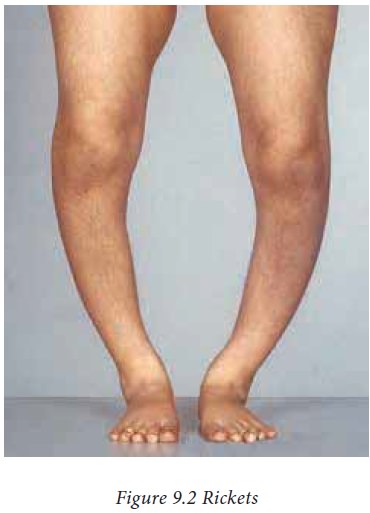
2. Phosphorus
Phosphorus
is the principal anion of the cell. It is widely present as phosphates in
proteins, nucleic acids and other various cellular components.Phosphorus and
calcium are related in sources and metabolism.
Functions
·
Phosphorus is essential for formation of bones and teeth.
·
High-energy phosphate compounds like ATP (Adenosine Tri Phosphate) and
Creatine Phosphate play a role in storage and transport of energy.
·
Phosphorylation and dephosphorylation reactions modify the activity of
many enzymes.
·
Phospholipids, the important constituent lipid of cell membranes and
nervous tissue contain phosphorus.
·
Acid-base balance is maintained by phosphate buffer in the kidneys.
·
Several co-enzymes such as NADP+ and TPP involved in
enzymatic reactions contain phosphate.
Sources:
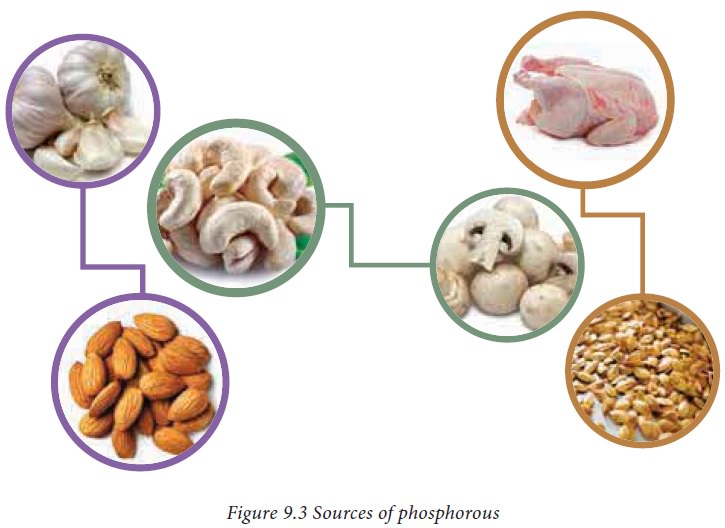
Foods
rich in calcium are also rich in phosphorus. Animal sources include fish, meat,
egg, milk, liver and kidneys. Plant sources of phosphorus are nuts, beans,
green vegetables and fruits.
Absorption and Excretion:
Both
calcium and phosphorus are absorbed from small intestine. Moderate amounts of
fatty acid favor absorption of phosphorus. High calcium content in diet
decreases the absorption of phosphorus.
Phosphates
are mainly excreted by the kidneys as sodium dihydrogen phosphate through
urine.
Deficiency:
Deficiency
states for phosphorus are rare. Rickets, osteomalacia and osteoporosis are
important dietary deficiency disorders of calcium and phosphorus. Low level of
blood phosphorus is characterized by defective bone and teeth formation.
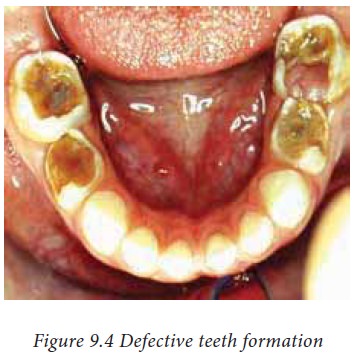
3. Sodium
Sodium
is the predominant cation of the extra cellular fluid. It is taken in the diet
as sodium chloride.
Functions:
·
Sodium ion is mainly associated with chloride and bicarbonate in the
regulation of acid-base equilibrium.
·
It maintains osmotic pressure of the body fluids and thus protects the
body against excessive fluid loss.
·
Sodium ions are involved in the transmission of nerve impulses.
·
It plays an important role in the absorption of glucose and nutrients
from small intestine by active transport.
·
Sodium ions are also involved in heart function.
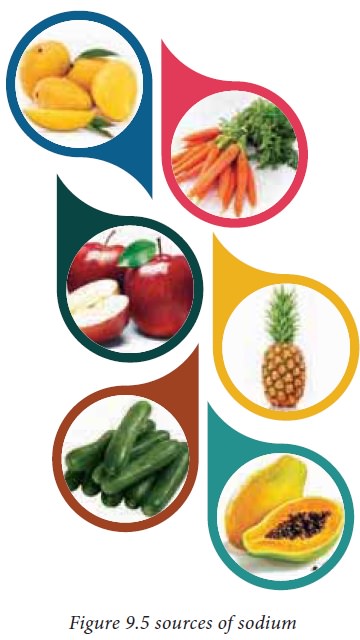
Sodium
is widely distributed in animal sources than plants. However, major source is
common salt used in cooking. Cauliflowers, carrot and milk are also good
sources of sodium.
Absorption and excretion:
Sodium
is completely absorbed from the gastro intestinal tract by active transport.
Normal diet contains about 5-10 grams of sodium as sodium chloride. The same
amount of sodium is excreted daily through urine and sweat.
Deficiency:
Mineralocorticosteroids
secreted by adrenal glands, regulate the metabolism of sodium. Decreased level
of plasma sodium(hyponatremia) may be due to lack of aldosterone and loss from
gastro-intestinal tract associated with conditions like diarrhoea.
4. Potassium
Potassium
is the main intracellular cation, about 98% of potassium is present inside the
cell.
Functions:
Many functions of potassium and sodium are carried
out in co-ordination with each other.
·
Potassium maintains the intracellular osmotic pressure, water balance
and acid-base balance.
·
Potassium, along with sodium influences neuromuscular activity of
cardiac and skeletal muscles.
·
The glycolytic enzyme, pyruvate kinase requires potassium as cofactor.
·
It maintains the alkalinity of the bile and blood.
·
Protein synthesis is dependent on potassium levels inside the cells.
Sources:
Animal
sources of potassium include meat, fish, egg and milk. Vegetables like onion,
carrot, fruits like apple, dates, banana, tender coconut water and grapes
contain potassium.
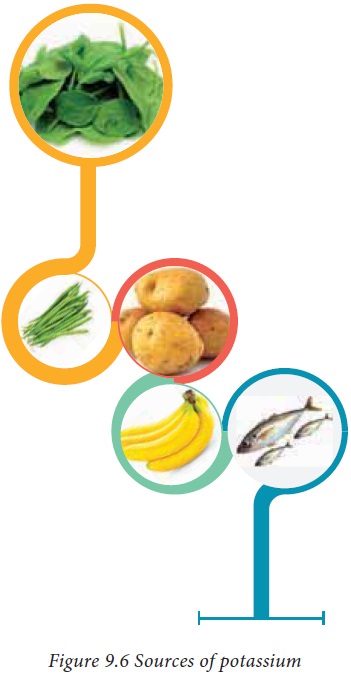
Absorption and excretion:
Potassium
is absorbed readily by passive diffusion from gastro intestinal tract and it is
mainly excreted in the urine.
Deficiency
Deficiency
of potassium leads to depression in cardiac and nervous system. Severe
vomiting, diarrhoea, loss of appetite, fasting or starvation over a long period
of time may lead to deficiency of potassium. It also occurs during renal
failure and shock. Fatigue, growth retardation, muscular weakness, heart and
respiratory dysfunction are common signs of potassium deficiency.
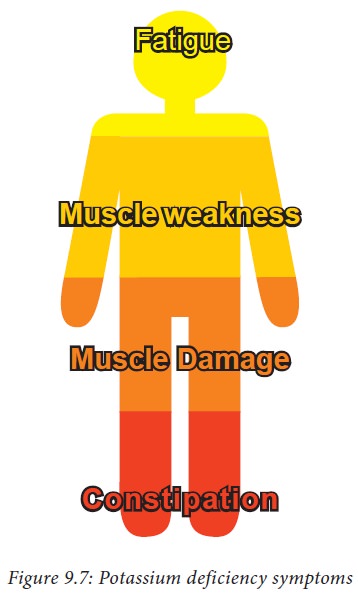
5. Chlorine
Chlorine
is taken in diet as sodium chloride. Chloride is the major anion in the
extracellular fluid.
Functions:
·
Chloride plays a vital role in acid-base balance by way of chloride
shift and maintains blood pH.
·
Chlorides also contribute to formation of gastric HCl.
·
It also helps to maintain plasma osmotic pressure.
·
Chloride ion is important as an activator of salivary amylase.
·
Chloride mainly acts as a counter ion against cations in maintaining the
electrical neutrality in body fluids.
Sources
Table
salt (Sodium chloride) is the main source of chloride.
Absorption and excretion:
Chloride
is completely absorbed from the gastro intestinal tract. Chloride is mainly
eliminated in the urine and also in the sweat.
Deficiency
Deficiency
states of chloride are rare. Most often, sodium and chloride are associated
with each other in their functions. Any clinical condition like dehydration,
affecting sodium concentration has an identical effect on chloride
concentration.
6. Magnesium
Magnesium
is the second most abundant intracellular cation after potassium. Adult human
body contains about 25g of magnesium. Bones contain nearly 70% of the body
magnesium contributing as magnesium phosphate, which is about 1.5% of bone
matter.
Functions
·
Magnesium, along with sodium, potassium and calcium controls the neuro
muscular irritability.
·
Magnesium is involved in the synthesis of proteins and nucleic acids.
·
Magnesium is essential for the activity of peptidases and ribonucleases.
·
It is an activator of many glycolytic enzymes, particularly in muscle.
·
Example : pyruvate kinase and enolase.
·
It plays an important role in oxidative phosphorylation.
Sources
Magnesium is widely distributed in
vegetables and also found in all animal tissues.

As magnesium is an essential part of
chlorophyll, green vegetables are important sources.
Absorption and excretion
Greater
part of the daily ingested dietary magnesium is absorbed from the small
intestine. The major quantity of magnesium is excreted in the feces and
remaining is excreted through urine.
Factors affecting absorption
· Excess of calcium decreases the absorption of magnesium.
· Vitamin D, parathormone and growth hormone increases the
absorption of magnesium.
Deficiency
The decreased level of serum
magnesium causes depression, tetany and muscular weakness.
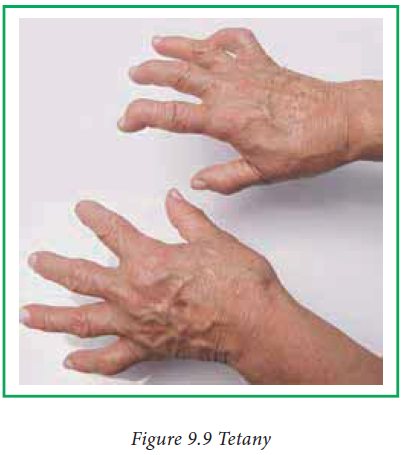
7. Sulphur
Sulphur is present in our body as
sulphur containing amino acids such as methionine and cysteine and also as
sulphate. B-complex vitamins like Thiamine and biotin contain sulphur.
Functions
·
S-Adenosylmethionine(SAM) acts as a methyl group donor for certain
enzymes.
·
Sulphur containing amino acids are responsible for structural
maintenance of proteins like insulin and keratin.
·
It is present in compounds like acetyl CoA and succinyl CoA which are
needed for various reactions.
·
Glutathione is a valuable sulphur containing Tripeptide needed for the
detoxification of H2O2.
·
Sulphur is present in heteropolysaccharides like heparin, a natural
anti-coagulant.
Sources
Sulphur intake is mainly in the form
of cysteine and methionine present in protein.
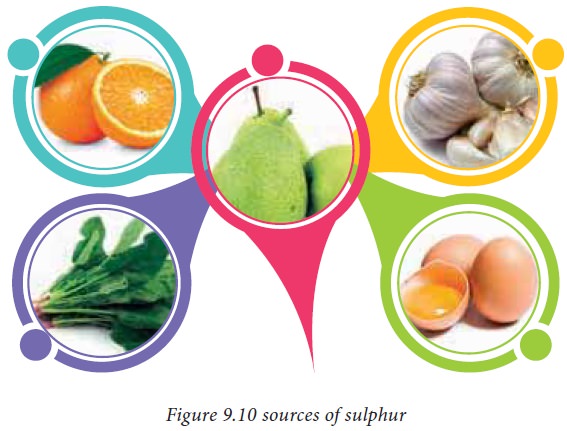
Adequate protein in diet fulfills
sulphur requirement.
Absorption and excretion:
Inorganic sulphate (SO42–)
is absorbed as such from the intestine into the portal circulation. Sulphur is
excreted in the urine.
Deficiency
Specific sulphur deficiency state has
not been reported in human beings.
Related Topics